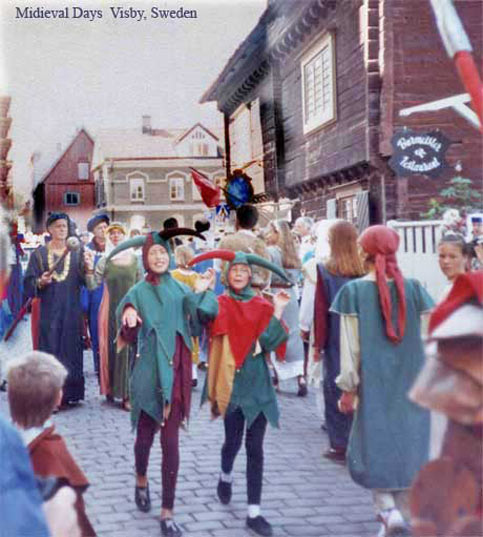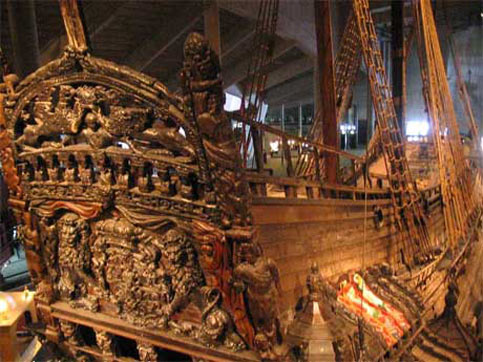Sweden
We had a spectacular time on our first trip to Sweden. We flew into Copenhagen, rented a car, and drove into and across Sweden, stopping at a number of interesting places along the way.
Like Orrefors- the cut crystal people.
Nancy watches a glassblower (above).
Both Nan and I enjoy seeing how things are produced, whether it is a handcrafted blowpipe being fashioned by natives in deep Africa, or dishes being fabricated in the potteries in England. Here, we are on the floor at Orrefors, watching
a master glass blower fashion what turned out to be a delicate vase.
A patient of mine had spent two years as a student in Visby, the capital of Gotland, a large island off the coast of Sweden. He thought we would enjoy spending some time with his "adopted family", and arranged everything for us before
we left the States. Turns out his "adopted father" had been the mayor of Visby, and so knew absolutely everyone in the town. We were well treated and well received everywhere we went.
By sheer chance, when we arrived the whole town was preparing for their annual Medieval Tournament, celebrating the fact that Visby is the oldest and best preserved Medieval city in Northern Europe. What a treat!
As I came out of our hotel the first morning there, I ran into the "Town Crier", in full costume, who asked if I and “My Lady” were planning on attending the champions’ joust later that afternoon. We chatted for a
few minutes, and upon learning "My Lady" was in a wheelchair, he told me he would make it a point to secure the best possible seats for us. I told him we would be there! |

|
As you see, everyone is in costume and they do their utmost to get visitors into the mood of the bygone times
|
It was a wonderful few days, and while we were there, we learned a great deal about the military history of the area. The Hanseatic League was quite a powerhouse in its day, and this
next story gives you some idea of what I mean:
In the 1600's, Sweden was a great military power. To keep it’s supremacy, the king ordered a warship to be built, a bigger, more powerful ship than anything else afloat.
And so it was that the WASA took shape. She was an awesome 64-gun warship, built in Stockholm, and launched in 1627. Of those 64 cannon, 48 could fire a 24 pound cannonball, making the
WASA, indeed, the most powerful ship of her time.
Can you imagine how proud the king and the ship builders were when they launched this formidable vessel? Surely they must have let their minds drift to contemplate the sweetness of military
victories far into the future, now that they had this super weapon.
As the WASA left her moorings and started to sail out of Stockholm Harbor, a fresh wind blew in from the sea, filling her sails- and overpowering the ability of the vessel to remain
upright. You see, they had placed the guns too high up in the ship, and she was extremely top heavy, a flaw they discovered when the ship capsized before even getting out of the harbor!
Most of the 64 guns were salvaged in 1663-1664. And then, somehow, the exact location of the wreck was lost, and she lay in the mud at the bottom of Stockholm Harbor for nearly 300 years,
until being re-discovered in 1956..
Turns out that the mud on the bottom of the harbor is especially dense and airless, two factors that preserved the ship from rot and decay. Thus, when you visit her today, the vast majority
of her original structure is intact, and very little new materials were used in her rebuilding. This lets us ‘modern’
visitors see exactly what life at sea was like in those times; not in an imagined environment, but in the real thing. |

Looking at the stern (rear) of the WASA, you can see some of the exquisite woodcarving that adorned her. Since we were there last, many of these carvings have been
painted, as they were originally, using colors and pigments appropriate to the 1600's. This was done to make the appearance of the ship all the more frightening.
As is customary even today, an investigation was launched to determine who should be punished for the disaster. After an exhaustive search, it seems (unofficially) it was entirely the
king's fault.
The shipbuilders had originally been given a design for a much smaller, shorter ship, but the king, in his quest for greater military supremacy, arbitrarily decided to add additional
height and guns to the ship- against the advice of the naval architects. Minor details...
We have visited this museum twice, and it was just as riveting the second time as it was the first. The building is easily accessible for wheelchairs, and should not be missed if you
are in Stockholm.
We know you are wondering: The exact number of those who drowned on that fateful day is not known, but it was over 100, for sure. A heavy price to pay for the king's folly.
Oh, the official report from the investigating committee?
Inconclusive. No one person, but a combination of events, including the unusual burst of wind- was responsible. No one was ever accused or convicted, and the king's name, of course,
was never mentioned. I guess nothing changes.. |
|
|
